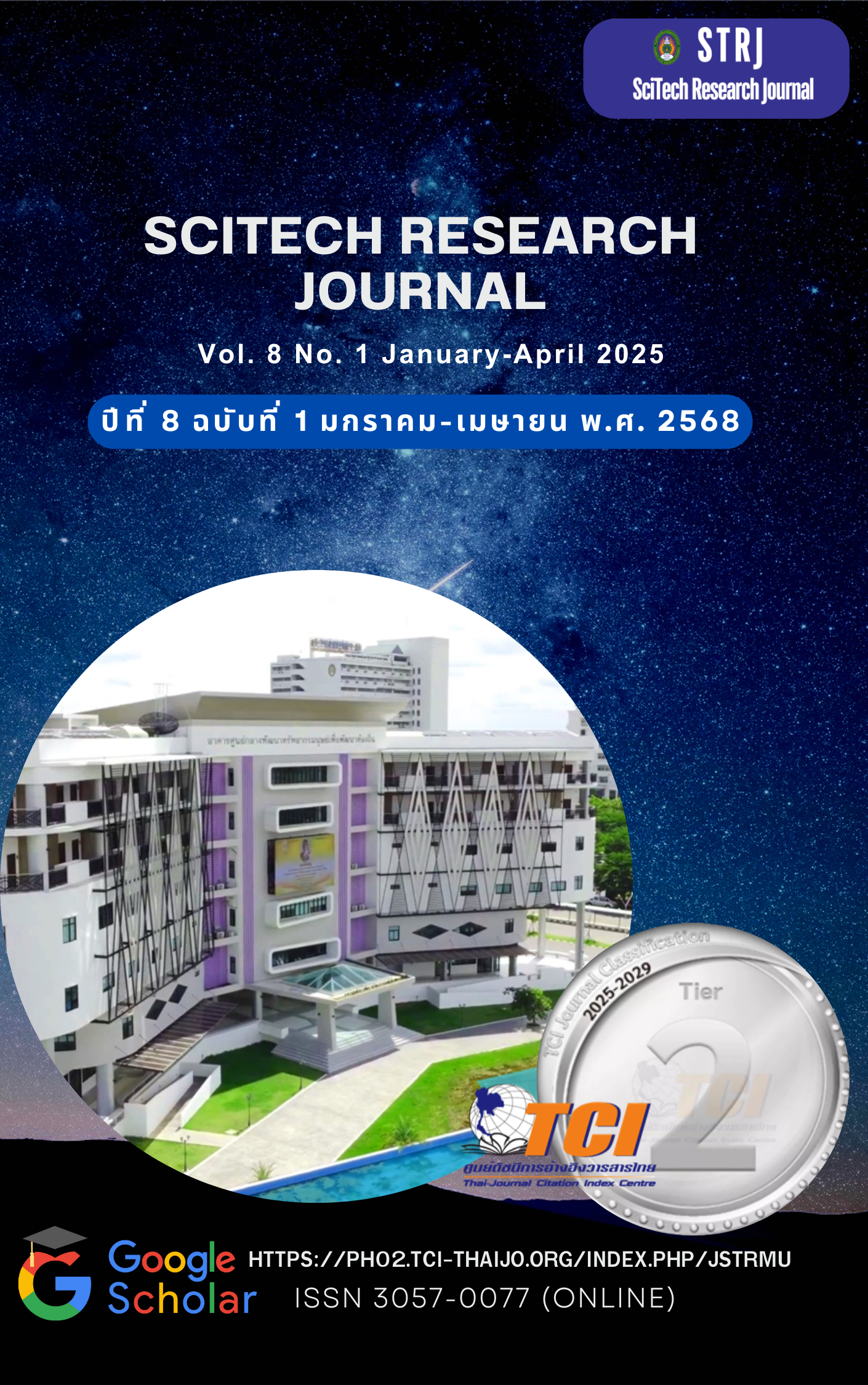Study on the properties of briquette fuels from cultivated banana peel mixed with Acacia wood
Keywords:
Biomass energy, Briquette fuel, Banana peel, acacia woodAbstract
This research aims to study the physical and chemical properties of fuel briquettes made from ripe banana peel mixed with acacia wood at different ratios: 100:0, 80:20, 60:40, 50:50, 40:60, 20:80, and 0:100, using tapioca starch as a binder. A Completely Randomized Design (CRD) was employed for the experimental setup. Data were analyzed statistically and presented as mean values. Differences among treatments were compared using Duncan’s Multiple Range Test (DMRT) at a 0.05 significance level. The study found that the optimal ratio for practical use is 20:80, as the properties of the briquettes largely met the community product standards, including: moisture content of 4.09%, ash content of 8.39%, volatile matter content of 3.60%, fixed carbon content of 83.89%, calorific value of 5,375 kcal per gram, density of 0.10 grams per cubic centimeter, consumption rate of 0.06 kilograms per hour, temperature rise rate of 3.62°C per minute, and a shatter index of 0.55. The findings from this research show that fuel briquettes made from ripe banana peel mixed with acacia wood can serve as an alternative energy source to replace charcoal.
References
Akam, N. G., Diboma, B. S., Mfomo, J. Z., Ndiwe, B., Bôt, B. V., & Biwolé, A. B. (2024). Physicochemical characterization of briquette fuel produced from cocoa pod husk: Case of Cameroon. Energy Reports, 11, 1580–1589. https://doi.org /10.1016/j.egyr.2024.04.113
Akpomie, G. K., & Conradie, J. (2020). Banana peel as a biosorbent for the decontamination of water pollutants: A review. Environmental Chemistry Letters, 18(4). https://doi.org/10.1007/s10311-020-00995-x
Anantanukulwong, R. Jehmae, R. & Sareenu, N. (2019). Production of charcoal briquettes from agricultural waste materials. Journal of Science and Technology, MR., 4(1), 47-53.
Asrori, A., Alfarisyi, M. F. S., & Naryono, E. (2024). Characterization of the bioenergy potential of corncob and rice husk mixtures in biochar briquettes. Evrimata: Journal of Mechanical Engineering, 1(1), 14–20.
Bot, B. V., Sosso, O. T., Tamba, J. G., Lekane, E., Bikai, J., & Ndame, M. K. (2021). Preparation and characterization of biomass briquettes made from banana peels, sugarcane bagasse, coconut shells, and rattan waste. Biomass Conversion and Biorefinery, 1–10.
Hoque, M., & Janaswamy, S. (2024). Biodegradable packaging films from banana peel fiber. Sustainable Chemistry and Pharmacy, 34. https://doi.org/10.1016/j.scp. 2023.101400
Katathikarnkul, S. (2015). Analysis of fuel properties from sugar palm materials. Thaksin University Press.
Kham-on, W. & Fukuda, S. (2022). Study of the properties of compressed fuel from cotton dust and coconut shell charcoal. Sukhothai Thammathirat Open University Journal of Science and Technology, 2(2),30-42.
Khanthongkam, H., Chaemwutthipreecha, R. & Saengsan, S. (2003). Biomass energy potential. Energy Development Office, Department of Alternative Energy Development and Energy Conservation, Ministry of Energy.
Koni, T. N., Banoet, Y., Wahon, W., Sabuna, C. Y., Same Radu, M. D., Rumlaklak, Y. Y., & Yuniwati Foenay, T. A. (2024). Anaerobic fermentation can improve banana peel nutrients and their use in crossbred native chicken diet. Advances in Animal and Veterinary Sciences, 12(2), 349–354. https://dx.doi.org/10.17582/journal.aavs /2024/12.2.349.354
Mahapram, K., Mongkol, S. & Kreekongkha, B. (2018). Processing of waste sludge from wastewater treatment system of dairy factory into compressed fuel. Bachelor of Science Thesis in Environmental Science.
Makphan, W. et al. (2021). Energy properties of fuel pellets from mangosteen peel and rubber wood. Burapha Science Journal, 26(3), 40-54.
Ngamlert, A., Sariphan, K. & Phengiew, P. (2019). Types of suitable binders for producing charcoal briquettes from eucalyptus bark. Thepsatri I-TECH Academic Journal, 14(2), 27–34.
Phakdikasa, M. & Phimphan, P. (2022). Fuel briquettes from lemongrass and banana peels. Nakhon Sawan Rajabhat University Journal of Science and Technology, 14(19),17-28.
Phanich, S. et al. (2019). Adding value of waste banana peels to remove toxins from water. Faculty of Science and Technology, Rajamangala University of Technology Phra Nakhon.
Sunthararak, S. et al. (2014). Development of compressed charcoal fuel from eucalyptus leaves and rubber leaves. The National and International Academic Conference, Buriram Rajabhat University.
Thepsasanakul, W. (2018). Study of the production of compressed fuel through carbonization process from agricultural waste materials such as coconut shells. College of Renewable Energy, Maejo University, Chiang Mai Province.
Thongchuchai, L., Patprakon, W. & Yaemsangsang, W. (2022). Study of the properties of compressed fuel from coffee waste and coconut waste. Sukhothai Thammathirat Open University Journal of Science and Technology, 2(2), 20-32.
Wirunphan, K., Saiplian, T. & Jaichompoo, P. (2017). Production of compressed fuel from waste materials in the production of sticky rice. Journal of Engineering, Rajamangala University of Technology Lanna, 2(1),1-15.
Yunusa, S. U., Mensah, E., Preko, K., Narra, S., Saleh, A., Dalha, I. B., & Abdulsalam, M. (2024). Optimizing selected quality metrics of rice husk briquettes: A response surface methodology approach. Biomass Conversion and Biorefinery, 1–19.



